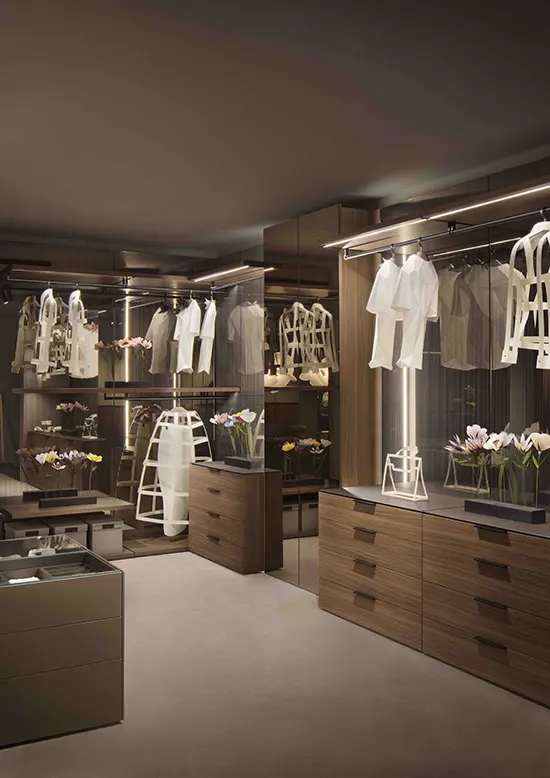In partnership with MiCodmc, a selection of establishments ripe for discovery during the 63rd edition of the Salone del Mobile.Milano, from 8th to 13th April

Kasane, design Nendo, Gervasoni
The collections and innovations showcasing elements and forms inspired by the natural world, dialoguing with sophisticated processing techniques, the creative insights of designers and, above all, companies’ increasingly close concern with the environmental impacts of production
At the 2023 edition of the Salone del Mobile.Milano the home became not only more welcoming and comfortable for those who live there, but also more sustainable, open and capable of embracing the whole of nature - rural or urban - surrounding it. The green and environmentally friendly approach appeared transversal to all the research conducted by the exhibiting companies.

Lema, VentiTre, design David Lopez Quincoces & Officinadesign
Materials characterized by imperfect textures, which favor tactile and primitive aesthetic components, entered the collections presented by the companies. They include natural fabrics, stone and raw wood, as well as coarse wool or satin-finish velvets. Then alongside these, many brands made high-tech materials the centerpiece of their products, capable of optimizing processes and fabrications with a view to lessening the impact of production on the environment: vegan leathers, plant-based polymers, eco-friendly paints and increasingly light coatings. A more fully aware lifestyle was presented by interior design projects. In them sustainability did not remain a mere technical component inherent in furnishings but permeated everyday activities by accustoming us to concepts such as reuse, recyclability and repairability - values at the heart of contemporary design, embracing the design and production phases as well as the role of objects in the home.

Aava 02, Arper, ph. Salva Lopez
The use of recycled and reusable materials was, for example, the main feature of VentiTre from Lema: a modular walk-in closet system with a high degree of customization. It can be easily dismantled for the correct disposal of each of its components and made with ecological panels of 100% carefully selected recycled wood. Then Arper presented the Aava 02 chair in post-consumer recycled polypropylene combined with virgin material, while Caimi launched Fiber 12, the first sound-absorbing fabric made by means of a technology using ECONYL® Nylon regenerated yarns, so meeting the growing demand for acoustic comfort with responsible and sustainable innovation.

Verdi, Salone del Mobile.Milano 2023, ph. Luca Quagliato
In this edition, companies and designers have also gone in search of raw materials with close ties to the local territory. And they have often explored traditional processing techniques, such as the Detalji bench from Nikari designed by Jenni Roininen, the Textile Falls collection from Verdi made out of natural fibers from the fig tree, banana plant, silk, alpaca, yaré and cumare, and woven metal threads. Or again the Biellese cashmere enhanced by Alonpi’s throws and cushions. Carpets from Battilossi were also woven out of precious yarns, while The House of Lyria presented collections developed in the heart of the Prato textile tradition, with dyes derived from organic sources such as coffee, tea or ashes. Sunbrella presented Heritage, the first line of the Renaissance program, which uses at least 50% recycled fibers and a water-efficient mass dyeing technology. Woodnotes is actually the world’s first company to use paper yarns in a contemporary key in the textile sector. At the Salone it presented Minore designed by Hanna Korvela.

Ruīna, Lithea, ph. Nino Bartuccio
Nature also inspired forms and surface finishes. The Neolith table from Poliform, for example, was inspired by great standing stones, the dolmens, rough on the outside and smooth on the inside. Likewise, More looked to the grandeur of the mountain landscape to create the Avar table with its double A-shaped supports for the solid wood top. The Dal Classico project by the Sicilian exterior cladding company Lithea continues its exploration of the Mediterranean through the interpretations of designers Astrid Luglio, Elena Salmistraro, Mario Scairato and Martinelli Venezia. Nendo chooses clay and designs for Gervasoni Kasane, a collection of tables and poufs that, thanks to the interplay of joints between different elements, become distinctly sculptural forms, rhythmically patterned by overlapping edges and the material texture of clay. For Pedrali, Pio and Tito Toso designed Anemos, a table with architectural and sinuous forms that seem sculpted by the wind and enhance the material qualities of concrete.














